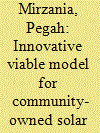| Srl | Item |
| 1 |
ID:
177306


|
|
|
|
|
| Summary/Abstract |
The main objective of this study is to provide a systematic decision support framework based on a holistic simulation approach that allows systematically the technical and economic analysis of a wind power plant (WPP). This model-based spread-sheet consists of various economic and technical indicators, including from the Weibull parameters to the cost of electricity generation. Various scenario-based analyses, namely WPP-1, WPP-2, and WPP-3, with wind turbines with different rated power are conducted for the proposed WPP. In this study, the capacity factor fluctuates from 25.62% to 30.03% while the annual electricity generation is in the range from a minimum of 22.449 MW and a maximum of 26.837 MW. Regarding economic indicators, the Internal Rate of Return (IRR) and the Levelized Cost of Electricity (LCOE) range from 11.7% to 17.38% and from 0.0665 €/kWh to 0.0771 €/kWh, respectively. By discussed and compared both economic and technical indicators, the most feasible scenario selection phase, which is the focal point of the study, is realized to construct and operate the proposed WPP. The developed simulation may be applied to other countries as well and in this way, it helps to be shaped strategic energy policies related to wind energy.
|
|
|
|
|
|
|
|
|
|
|
|
|
|
|
|
| 2 |
ID:
175252


|
|
|
|
|
| Summary/Abstract |
The progressive withdrawal of the Feed-in-Tariff provided by the UK government has left community-owned solar photovoltaic projects facing significant financial challenges. They urgently need to develop alternative business models that will enable them to develop new projects and recuperate their costs in this post-subsidy era. One promising possibility is the incorporation of storage technology. However, currently it cannot be denied that the financial viability of this type of model is in question. This paper investigates whether and how integrated solar and battery storage system would be financially viable, using the System Advisor Model as a simulation tool to conduct techno-economic analyses.
|
|
|
|
|
|
|
|
|
|
|
|
|
|
|
|
| 3 |
ID:
192807


|
|
|
|
|
| Summary/Abstract |
Grid-connected photovoltaic (PV) facilities are more attractive than ever due to the electricity price surges and the reduction of solar energy generation costs. This paper develops a solving procedure including a simulation model to analyze the techno-economic performance of PV-battery facilities, taking into account the latest Spanish regulatory framework. The procedure finds the best facilities for multiple objectives, maximum profitability and maximum self-sufficiency, in different locations, load profiles and economic scenarios. The results indicate that PV modules are profitable without subsidies, with installations between 1 and 6 kWp. Meanwhile, batteries are only convenient when seeking maximum independence from the grid, with capacities up to 9 kWh. The findings suggest that the economic feasibility of facilities is influenced by the location and compensation rate surplus electricity, while the facility is mainly determined by the load profile. A sensitivity analysis shows that a variation in grid tariffs and technology prices has a limited impact on the facility's size but modifies the system's profitability. Finally, an analysis of the latest unprecedented grid price surges indicates that self-consumption facilities help become a more resilient society against unexpected events. Therefore, policymakers should keep promoting the adoption of these technologies and keep the current advantageous regulations.
|
|
|
|
|
|
|
|
|
|
|
|
|
|
|
|